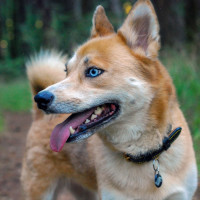Appearance of the Siberian Shiba
|
| Siberian Shiba have physical traits derived from both the Siberian Husky and the Shiba. It can be difficult to determine which characteristics will be developed from each parent, as some dogs will adopt different traits from others. Overall, the Siberian Shiba is a compact, proportionate dog with plenty of muscle. It is sometimes described as a wolf or fox, with intelligent eyes and erect ears. They usually have a bushy tail and an expressive face. The eyes are almond-shaped, small and can be different colors, with some dogs having eyes of two different colors. Siberian Shiba ears are triangular, erect and small, though proportionate to the size of the body and head. They are well set and inclined forward at an angle that corresponds to the arched neck. The body, which is distinctly male or female, is not as tall as it is long. Their feet have arched toes and are compact and feline with thick pads. |
Temperament of the Siberian Shiba
|
| The Siberian Shiba is a magnificent breed, but it can sometimes be difficult to handle, especially if owners are unfamiliar with its parent breeds. Both the Siberian Husky and Shiba breeds are very independent dogs that also have a very strong propensity for hunting. They are also highly intelligent and good at escaping. As a result, the Siberian Shiba should always be kept on a leash or in a secure area. This breed can also be inquisitive, like its Husky relative. It can be difficult to determine with certainty certain traits of this designer breed, as some aspects of the Siberian Husky and the Shiba are opposites. For example, the Shiba is very independent and doesn't generally crave affection. The Siberian Husky, on the other hand, needs constant human companionship and can become upset when left alone. This hybrid breed is generally suited to homes with children, although it should be supervised in the presence of young children. |
Needs and activities of the Siberian Shiba
|
| Based on the activity levels of the Siberian Shiba's parent breeds, we can conclude that these dogs will be very active. This means they'll need to exercise for around 60 to 90 minutes a day. As this is a highly intelligent breed, it also needs some mental stimulation throughout the day. These dogs absolutely need obedience training, as they are very strong mentally. To teach these dogs, you need to be confident and firm, but not aggressive. They prefer cold weather and should not be over-exercised in hot weather. Not at all suited to apartment living, they need a safe enclosure in which to play - ideally a fenced garden where they can get fresh air several times a day. |
Maintenance of the Siberian Shiba
|
| This hybrid breed will certainly need frequent brushing. This is obvious, as Shibas shed a lot and Siberian Huskies even more. So be prepared to spend some time brushing your dog, and don't be surprised if you have to vacuum often. Siberian Huskies need to be brushed at least once a week, but don't need to be bathed regularly, as they're clean enough and wash themselves. The Shiba will need brushing and bathing from time to time, but maintenance is fairly straightforward. Other needs include brushing your dog's teeth, which should be done at least two or three times a week. This simple but essential task will prevent teeth decay and gums from becoming sensitive. Ears should be cleaned weekly to prevent ear infections, and nails trimmed once or twice a month. How often your dog needs his nails trimmed depends on his lifestyle and activity level. |









 English (United Kingdom)
English (United Kingdom)